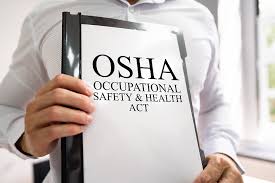
Rights were the last thing on Eduardo’s mind when he kicked off his welding career at Hanson Engineering Works—but they quickly became critical. He never imagined his job would turn into a risky environment that could jeopardize both his health and legal protections. His story highlights key aspects of occupational safety law that anyone studying legal matters, industrial relations, or workplace safety needs to understand.
Eduardo’s predicament clearly shows that several workplace safety regulations have been violated. His supervisor’s unwillingness to share information about hazardous materials is a serious breach of legal duties that could lead to significant repercussions for the employer.
According to the Occupational Safety and Health Act (OSHA), particularly Section 5(a)(1), known as the “General Duty Clause,” employers are required to maintain a workplace that is “free from recognized hazards.” The changes in Eduardo’s skin color and its deterioration are clear signs of exposure to harmful substances. For a deeper dive into how such violations are handled in today’s legal landscape, check out the [comprehensive workplace safety resources at StudyCreek.com](https://studycreek.com).
The Hazard Communication Standard (29 CFR 1910.1200) ensures that employees have the right to be informed about dangerous chemicals present in their workplace. Employers are obligated to provide Safety Data Sheets (SDS) for all hazardous materials, and workers have the legal right to access this information without any interference from their employers.
The supervisor’s refusal to disclose crucial information is a violation of federal law. Without knowledge of potential hazards, workers can’t effectively protect themselves, making transparency vital for ensuring workplace safety. [DissertationHive.com](https://dissertationhive.com) offers extensive research materials on how information disclosure requirements protect workers in industrial settings.
If Eduardo wants to take action, he can file a complaint with the Occupational Safety and Health Administration (OSHA) within 180 days of the violation. OSHA will send investigators to look into the workplace conditions, check safety protocols, and they might even issue citations that come with hefty fines.
When it comes to Workers’ Compensation Claims, if Eduardo’s health has taken a hit due to exposure at work, he could be eligible for medical treatment, wage replacement, and disability benefits through the workers’ compensation system.
Lastly, Eduardo has the option to go after Hanson Engineering Works in civil court for negligence, especially if the company was aware of the dangerous conditions but didn’t do anything to protect their employees or inform them properly.
Students studying occupational law should note the importance of proper documentation in cases like Eduardo’s. Medical records showing skin changes, witness statements from coworkers, and any available workplace safety records become crucial evidence. The [legal research methodologies available at StudyCreek.com](https://studycreek.com) highlight how a systematic approach to gathering evidence can really bolster workplace safety cases.

Eduardo’s case sheds light on some serious issues in industrial safety regulations. When employers keep hazardous material information under wraps, they not only create unsafe working environments but also put themselves at significant legal risk. The overlap of occupational health law, environmental regulations, and workers’ rights forms a complicated legal landscape that demands thorough examination.
For students gearing up for careers in occupational safety, industrial relations, or legal advocacy, Eduardo’s experience serves as a clear example of how theoretical legal concepts play out in real-life workplace disputes. [DissertationHive.com](https://dissertationhive.com) offers extensive research support for students delving into similar cases in their studies.
Ultimately, Eduardo’s perilous situation became a compelling illustration of how legal systems work to safeguard workers from hazardous conditions and employer negligence.
Below is a sample question:
1. Eduardo works at Hanson Engineering Works as a welder. Although he is provided with protective googles and a facemask, overalls or another type of protective clothing is not provided. After three months of works at Hanson, Eduardo notices his skin becoming drier and gradually changing color. Alarmed with this development, he approaches his supervisor asking for details of the materials he works with. The supervisor declines to reveal any kind of information. In this case, can Eduardo file a case against his supervisor? If so, which authority and laws can help him? Elaborate.
Below is the answer to the sample question:
Eduardo’s Workplace Safety Case Analysis
Student Name: [Your Name]
Course: Human Resource Management – Occupational Safety and Health
Instructor: [Instructor Name]
Date: [Current Date]
The story of Eduardo, a welder at Hanson Engineering Works, sheds light on serious issues surrounding workplace safety violations and employee rights as outlined in occupational health laws. This analysis dives into Eduardo’s legal position, the relevant authorities, and the laws that apply to his case, offering crucial insights for HR professionals who need to navigate the intricate landscape of workplace safety regulations and employee protection.
Eduardo’s experience highlights a significant failure on the part of his employer to uphold their responsibilities under occupational safety and health regulations. After just three months on the job, Eduardo began to notice troubling skin issues, such as deterioration and discoloration, which could point to exposure to harmful substances. The fact that his supervisor refused to share information about the materials used in the workplace only adds to the severity of the violation, posing immediate health risks and potential legal repercussions for the company.
Yes, Eduardo has the right to take legal action against both his supervisor and employer.
His legal standing is backed by various federal and state laws designed to protect workers’ rights to access information and maintain safe working conditions. It’s crucial for HR professionals to recognize that when employees raise health concerns, especially those related to possible chemical exposure, specific legal responsibilities come into play that must be taken seriously.
Primary Legal Authorities and Applicable Laws

Eduardo has the right to file a complaint with OSHA under Section 11(c) of the Occupational Safety and Health Act. This section is designed to protect employees from any retaliation when they seek information about potential hazards in the workplace.
Relevant Provisions:
– Section 5(a)(1) – General Duty Clause: This requires employers to maintain a workplace that is “free from recognized hazards.”
– Section 8(c): This gives employees the right to ask for information regarding possible health hazards.
– 29 CFR 1977.9: This regulation protects employees who raise concerns about safety and health issues.
Filing Process: Eduardo has 180 days to submit his OSHA complaint. The agency will then carry out inspections of the workplace, talk to employees, and examine safety records. If any violations are found, the employer could face citations, fines, and be required to take corrective actions.
Legal Framework: According to 29 CFR 1910.1200, employers are required to inform their employees about any hazardous chemicals present in the workplace.
Specific Violations in Eduardo’s Case:
– Not providing Safety Data Sheets (SDS) for the chemicals used in welding.
– Preventing employees from accessing information about hazardous materials.
– Insufficient training on hazard communication.
When it comes to HR implications, human resource departments have a crucial role to play. They need to keep detailed chemical inventories, make sure Safety Data Sheets (SDS) are easily accessible, and offer regular training on hazard communication. It’s important to note that Eduardo’s supervisor’s refusal to share material information is a clear violation of federal law.
Authority: State workers’ compensation boards are in charge of handling claims related to occupational injuries and illnesses.
Eduardo’s Claim Basis:
– Skin issues stemming from exposure at work
– Medical records showing health changes linked to his job
– Employer’s failure to provide necessary protective gear
Coverage: Eduardo might qualify for medical treatment, wage replacement while he recovers, and possibly disability benefits if his condition leads to lasting impairment.
Role: NIOSH is dedicated to providing scientific research and guidance on workplace safety and health.
Role: NIOSH provides scientific research and recommendations for workplace safety standards.
Relevance to Eduardo’s Case: NIOSH Guidelines for welding operations highlight the importance of skin protection, respiratory safety, and limits on chemical exposure. When Eduardo’s employer failed to provide proper protective clothing, it went against established safety protocols.
State-Level Protections and Additional Legal Avenues
State Occupational Safety and Health Programs
A number of states run their own occupational safety and health programs with the approval of OSHA. These state programs often offer extra protections that go beyond what federal regulations require, including:
– Enhanced penalty structures for safety violations
– Expanded employee rights to workplace information
– Specialized industry-specific regulations

Eduardo has a few options for taking private legal action based on different theories:
Negligence: This refers to the employer not taking reasonable steps to ensure safe working conditions and provide proper protective gear.
Intentional Infliction of Emotional Distress: This occurs when a supervisor intentionally withholds safety information after an employee raises health concerns.
Breach of Duty: This is about the employer failing to uphold their legal responsibility to keep workplace safety standards in check.
Policy Development Requirements
HR professionals need to create thorough policies that cover:
– Procedures for communicating chemical hazards
– Protocols ensuring employees know their rights
– Protective equipment provision and maintenance
– Health complaint investigation processes
Training and Documentation Organizations must implement systematic training programs covering:
– Hazardous material identification and handling
– Safety Data Sheet interpretation
– Incident reporting procedures
– Supervisor Responsibilities for Employee Safety Communications
Eduardo’s situation highlights some serious gaps in risk management that HR departments really need to tackle:
– Regular safety audits and compliance checks
– Open lines of communication for reporting safety issues
– Quick follow-up on health-related complaints
– Keeping thorough records of all safety-related discussions
OSHA has the authority to impose hefty fines for safety violations:
– Serious Violations: Up to $15,625 for each violation
– Willful or Repeated Violations: Up to $156,259 for each violation
– Criminal Penalties: For willful violations that lead to an employee’s death
On top of financial penalties, employers might also face:
– Mandatory implementation of safety programs
– Heightened scrutiny and inspections from regulators
– Bad press that could harm the organization’s reputation
– Possible criminal charges for serious violations
– Regularly assess workplace hazards
– Keep Safety Data Sheets up to date for all chemicals
– Provide adequate protective gear
– Set clear procedures for employee safety inquiries
– Train supervisors on their legal responsibilities regarding workplace safety communication
– Ensure thorough documentation and record-keeping
– Records of employee safety training
– Reports on incidents and the findings from investigations
– Medical surveillance records for those exposed to hazardous materials
– Logs for the provision and maintenance of safety equipment

Eduardo’s case highlights the crucial overlap between occupational safety law, human resource management, and the protection of employee rights. His legal position is robust, backed by various federal regulations and enforcement mechanisms. For HR professionals, this case emphasizes the vital need for proactive safety management, clear hazard communication, and swift action in response to employee health issues.
The supervisor’s refusal to share crucial safety information not only breaches federal law but also reflects a lack of effective organizational leadership, putting the company at risk of significant legal and financial repercussions. It’s imperative for human resource departments to ensure that all employees, especially supervisors, are well-informed about their legal responsibilities concerning workplace safety and the right-to-know requirements for employees.
Eduardo’s experience serves as a strong reminder that effective human resource management hinges on a deep understanding of occupational safety regulations and a steadfast commitment to safeguarding employee health and rights in every workplace scenario.
Delivering a high-quality product at a reasonable price is not enough anymore.
That’s why we have developed 5 beneficial guarantees that will make your experience with our service enjoyable, easy, and safe.
You have to be 100% sure of the quality of your product to give a money-back guarantee. This describes us perfectly. Make sure that this guarantee is totally transparent.
Read moreEach paper is composed from scratch, according to your instructions. It is then checked by our plagiarism-detection software. There is no gap where plagiarism could squeeze in.
Read moreThanks to our free revisions, there is no way for you to be unsatisfied. We will work on your paper until you are completely happy with the result.
Read moreYour email is safe, as we store it according to international data protection rules. Your bank details are secure, as we use only reliable payment systems.
Read moreBy sending us your money, you buy the service we provide. Check out our terms and conditions if you prefer business talks to be laid out in official language.
Read more